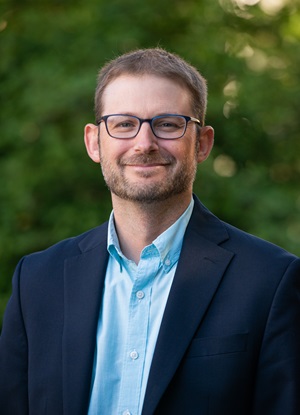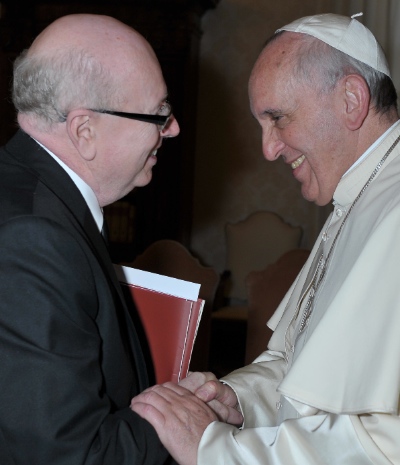
Metro Vancouver resident Geoff Tunnicliffe was head of the World Evangelical Alliance when he met (twice) with Pope Francis in 2014.
With the Week of Prayer for Christian Unity upon us (January 18 – 25) Nicholas Olkovich offers some background regarding the Roman Catholic Church’s evolving approach to ecumenism, spirituality and mutual learning.
Ecumenism is one of those things that some Christians, including a fair number of Catholics, seem to think isn’t all that important. Why should we care about Christian unity when we have our own internal issues?
Well, frankly, because Jesus desires and prays for the unity of his disciples, a unity that is a participation in the communion of the three divine persons: Father, Son and Holy Spirit.
The clearest example of this call is found in Jesus’ high priestly prayer, his prayer to the Father on the night before his passion and death in John 17:20-23:
I ask not only on behalf of these, but also on behalf of those who will believe in me through their word, that they may all be one. As you, Father, are in me and I am in you, may they also be in us, so that the world may believe that you have sent me.
The glory that you have given me I have given them, so that they may be one, as we are one, I in them and you in me, that they may become completely one, so that the world may know that you have sent me and have loved them even as you have loved me.
Almost 2,000 years later, the Fathers of the Second Vatican Council – a worldwide gathering of Catholic bishops that ran from 1962 – 1965 – would open Lumen Gentium, the Dogmatic Constitution on the Church, by speaking of the church not first and foremost as a visible and hierarchical institution but rather as a “mystery of communion.”1
We are united vertically through Christ to God the Father and to one another as members of the one Body of Christ by the power of the Holy Spirit. In its opening article, the Council Fathers contended that the church is called to serve as a sacrament or visible sign and instrument of this mystery in human history, to illustrate to the world what it means to live in right relationship with God and neighbour.2
Conflicts and divisions that hinder full communion among Christians contradict the unity to which we are called and thereby damage our credibility and witness. How can we proclaim the Gospel of reconciliation – a message of love – to a world marked by exclusivism and polarization while at the same time quarreling with our brothers and sisters in Christ?
Ecumenism is not an optional ‘appendix’ which can be added to the ‘church’s traditional activity’ but rather it is a constitutive dimension of the church’s mission.3 This journeying or walking together with other Christians towards full and visible communion pertains – not merely to theologians or church leaders – but rather to the entire people of God.
Beyond an ‘ecumenism of return’
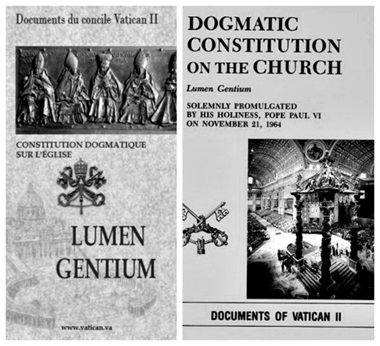 Vatican II marked an important shift in the Catholic Church’s approach to these issues. For much of the first half of the 20th century, the Roman Catholic hierarchy was quite suspicious of ecumenical initiatives.
Vatican II marked an important shift in the Catholic Church’s approach to these issues. For much of the first half of the 20th century, the Roman Catholic hierarchy was quite suspicious of ecumenical initiatives.
More specifically, in the decades preceding the Second Vatican Council, the Catholic Church officially favoured what scholars term a return model of ecumenism or an ‘ecumenism of return’ which, in reality, is not very ecumenical at all.
The tendency was to identify non-Catholic Christians as heretics or schismatics and to contend that unity – the healing of the wounds of division – depended on individual non-Catholics returning to the one ‘true church of Jesus Christ,’ the Roman Church.4
Informed by the Council Father’s retrieval of an ancient ecclesiology of communion, both Lumen Gentium and Unitatis Redintegratio – the Council’s landmark Decree on Ecumenism5 – moved beyond the narrow tendency to identify the one Church of Christ with the Roman Catholic Church by holding two elements in tension.
Both elements find unique expression in Lumen Gentium #8, an oft quoted and misunderstood text:
This Church [the one Church of Christ] constituted and organized in the world as a society, subsists in the Catholic Church, which is governed by the successor of Peter and by the Bishops in communion with him, although many elements of sanctification and of truth are found outside of its visible structure. These elements, as gifts belonging to the Church of Christ, are forces impelling toward catholic unity.
Although a lot of ink has been spilled in Catholic circles about the meaning of subsists here, most mainstream commentators read the term as implying that the one Church of Christ continues to exist in a unique or privileged though not exclusive way in the Catholic Church.
This nuance allowed the Council Fathers to affirm that there are many elements of holiness and truth belonging to the one Church of Christ that are present beyond the visible boundaries of the Catholic Church.6 It is these elements – these ecclesial signs that mediate salvation – that constitute the basis for the communion, albeit imperfect, that exists between Catholics and non-Catholic Christians.
Spiritual ecumenism
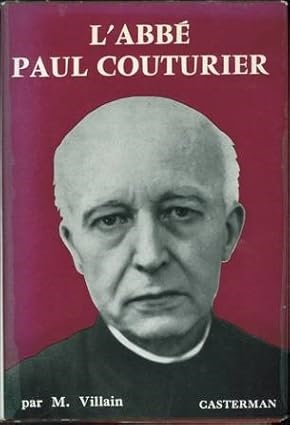 The movement beyond an ecumenism of return is grounded in what Unitatis Redintegratio (UR) describes as “spiritual ecumenism,” the heart and soul of the “whole ecumenical movement.”7
The movement beyond an ecumenism of return is grounded in what Unitatis Redintegratio (UR) describes as “spiritual ecumenism,” the heart and soul of the “whole ecumenical movement.”7
In UR #7, the Council Fathers note that “there can be no ecumenism worthy of the name without a change of heart.” This “change of heart” is intimately connected to Vatican II’s broader vision of renewal and reform and its conception of the church as a pilgrim people of God called to ongoing repentance, purification and holiness of life.
For Abbé Paul Couturier (1881 – 1953), the great French pioneer of spiritual ecumenism, the biggest obstacle to ecumenical progress was a sort of spiritual superiority or exclusivism that inclines us to identify our own community with the one Church of Christ.
The conversion that Couturier calls for demands that we die to our confessional pride or egotism and that we place fidelity to Christ and the Gospel ahead of our distinctive ecclesial identities.
This shift from ecclesial absolutism to genuine mutuality is a function of vertical communion and dialogue with God. The more we are united to Christ and the Father by the power of the Spirit, the more deeply we are drawn together in love for one another.
Authentic communion with God is the source of our desire for Christian unity but also of those attitudes of self-denial, humility and charity that enable personal and ecclesial self-reflection and renewal. When we enter the high priestly prayer of Christ, he challenges us to identify, confess and repent of those sins – both personal and structural – that reinforce division and to recognize the presence of God’s love in other traditions.8
Mutual learning and receptive ecumenism
This last point is especially important. If the process of reform begins at home, spiritual ecumenism opens us up to the possibility of learning from Christ and the Spirit present in other confessions.
This emphasis on ecumenical learning – what Popes John Paul II and Francis have both described as a “mutual exchange of gifts” – has been expanded in recent years by theologians like Paul D. Murray and other proponents of “receptive ecumenism.”9
Receptive ecumenism shifts the focus of dialogue from teaching – where the other is regarded as ignorant – to learning from those who are different in two steps.
First, it demands that we repent of our confessional vanity and exclusivism and recognize our own limitations, distortions and areas for growth.
Second, it demands that we open ourselves to the presence and activity of God in the teachings, structures and practices of other communities with an eye to identifying a match between our own gaps or weaknesses and another community’s particular gifts or strengths that respond to them. Motivated by a deepening relationship with God, the hope is that as members of each community learn from one another they will gradually come closer together.
Pope Francis has been especially clear about this last point:
to journey together is already to be making unity! . . . unity will not come about as a miracle at the very end. Rather, unity comes about in journeying; the Holy Spirit does this on the journey. If we do not walk together, if we do not pray for one another, if we do not collaborate in the many ways that we can in this world for the People of God, then unity will not come about.10
Although Roman Catholics believe that the goal of ecumenical dialogue is ‘full visible communion,’ the latter does not require a uniformity that levels all confessional differences. Rather, Christian unity ought to be understood along the lines of an ecclesiology of communion that recognizes and affirms the unique gifts of each confession.
For example, the noted and now deceased Canadian theologian and ecumenist Margaret O’Gara spoke of the church as a mosaic, where every piece, every gift, is needed for the “full picture of the one Church of Christ.”11 This unity is not a result of our own efforts but rather of the Spirit that reconciles and preserves our legitimate differences.
Synodality and receptive ecumenism
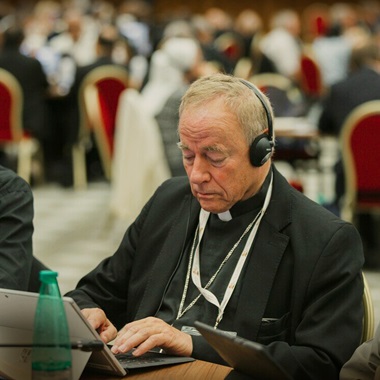
Archbishop Michael Miller at the second Synod on Synodality (in 2023 and 2024) in Rome. (Synod.va photo)
Allow me to end here by highlighting two examples of Catholic learning which are united by the common and timely theme of synodality.
In reality, ecumenism and synodality are closely related. As Pope Francis notes, “the path of synodality, which the Catholic Church is on, is and must be ecumenical, just as the ecumenical path is synodal.”12
Both paths are intimately interrelated ways of journeying together in service to the Church’s mission that ought to be marked by mutual listening and learning. Central to both is the call to conversion, ecclesial self-reflection and reform.
Like ecumenism, synodal discernment is a spiritual discipline that demands pastoral conversion, a transformation born of renewed encounter with Christ that enables us to listen to and learn from one another and the Holy Spirit.
Noted Roman Catholic ecumenist and theologian Cathy Clifford – a lay Canadian delegate to the recent Synod on Synodality – underscores how Catholic learning about the experience and practice of synodality in other confessions has played an important role in the development of synodality in recent years within the Catholic Church.13
Since Vatican II, Catholics have come to more deeply appreciate how the entire people of God, both Catholics but also non-Catholic Christians, possess a supernatural sense of the faith – the sensus fidei – an instinct or spiritual capacity, aroused and sustained by the Holy Spirit, that assists them in discerning how to interpret and live the Gospel.14
This is one of the reasons why in the lead up to the recent Synod on Synodality, ecumenical engagement, consultation and participation was encouraged at all levels of the church, from the local parish up to the Synod of Bishops in Rome.
This first example is closely connected with a second. In his own reflections on ecumenism, Pope John Paul II noted that those who have been elected bishop of Rome are not exempt from the call to conversion and asked forgiveness for those times in history when the ministry of the papacy was exercised, not as a service to unity in the Spirit but rather in heavy-handed monarchical terms.
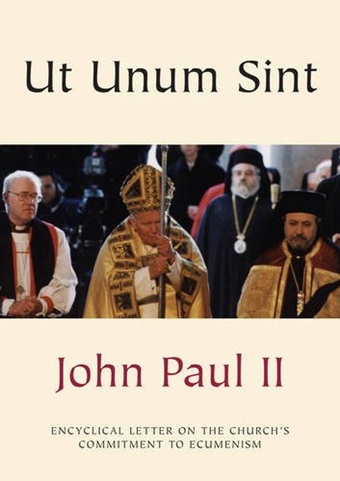
Version 1.0.0
Both Popes John Paul II and Francis view the ministry of the bishop of Rome as a gift that might be shared with the universal church, yet both are also aware of the need to re-think the exercise of this ministry so that it might be a force for unity rather than an ongoing cause of division and conflict.
In Ut Unum Sint, John Paul II invited theologians and church leaders in other traditions to engage in a “patient and fraternal dialogue,” a “dialogue in which leaving useless controversies behind, we could listen to one another, keeping before us only the will of Christ for his Church.”15
The fruit of that dialogue has found expression in the Dicastery for Promoting Christian Unity’s newly published document: The Bishop of Rome: Primacy and Synodality in Ecumenical Dialogues and Responses to the Encyclical Ut Unum Sint16 but also in Pope Francis’ more synodal approach to papal primacy.
Conclusion
Many of us will gather later this month to celebrate the Week of Prayer for Christian Unity to reaffirm what unites us as Christians and to repent of what continues to separate us.
Communal prayer sits at the heart of the spirituality that Abbé Couturier regarded as central to the ecumenical movement. By deepening our relationship with Christ in prayer we strengthen our capacity to listen to, learn from and collaborate with our separated sisters and brothers.
Our commitment to journeying towards unity with other Christians within the one Body of Christ is closely connected with our efforts as Christians to foster mutuality and the common good in the wider world. The two are inseparable. If we can’t commit to loving other Christians, how can we expect the Gospel to resonate in a world wracked by injustice, exclusivism and polarization?
It is this witness to the mystery of communion that is essential, as Pope Francis notes, to restoring the credibility of the church in the contemporary world.
1 See Paul VI, Lumen Gentium – Dogmatic Constitution on the Church (1964), chapter 1, https://www.vatican.va/archive/hist_councils/ii_vatican_council/documents/vat-ii_const_19641121_lumen-gentium_en.html
2 Lumen Gentium, #1.
3 John Paul II, Ut Unum Sint – On Commitment to Ecumenism (1995), #20, https://www.vatican.va/content/john-paul-ii/en/encyclicals/documents/hf_jp-ii_enc_25051995_ut-unum-sint.html
4 For example see Pius XI, Mortalium Animos – On Religious Unity (1928), https://www.vatican.va/content/pius-xi/en/encyclicals/documents/hf_p-xi_enc_19280106_mortalium-animos.html
5 Paul VI, Unitatis Redintegratio – Decree on Ecumenism (1964), https://www.vatican.va/archive/hist_councils/ii_vatican_council/documents/vat-ii_decree_19641121_unitatis-redintegratio_en.html
6 For a representative list of these elements see Lumen Gentium, #15 and Unitatis Redintegratio, #3.
7 Unitatis Redintegratio, #8.
8 For more on Couturier and the roots of what Unitatis Redintegratio terms “spiritual ecumenism” see Catherine E. Clifford, “Towards a Spirituality of Receptive Ecumenical Learning,” in Receptive Ecumenism as Transformative Ecclesial Learning: Walking the Way to a Church Re-Formed. Edited by Paul D. Murray, Gregory A. Ryan, and Paul Lakeland (Oxford, 2022).
9 For a helpful introduction to the receptive ecumenical project see Paul D. Murray, “Receptive Ecumenism and Catholic Learning: Establishing the Agenda,” International Journal for the Study of the Christian Church 7 (2007): 279-301.
10 Pope Francis, Homily for the Vespers on the Solemnity of the Conversion of Saint Paul the Apostle, 25 January 2014, https://www.vatican.va/content/francesco/en/homilies/2014/documents/papa-francesco_20140125_vespri-conversione-san-paolo.html
11 Margaret O’Gara, The Ecumenical Gift Exchange (Liturgical Press, 1998), viii.
12 Pope Francis, Address of His Holiness Pope Francis to His Holiness Mar Awa III Catholicos-Patriarch of the Assyrian Church of the East, 19 November 2022, https://www.vatican.va/content/francesco/en/speeches/2022/november/documents/20221119-patriarca-chiesa-assira.html
13 This is presented as one of the principal elements of Catholic learning in the Anglican-Roman Catholic International Commission’s 2017 document Walking Together on the Way: Learning to be Church – Local, Regional, Universal: https://iarccum.org/archive/ARCIC3/2018_SPCK_ARCIC-III_Walking-Together-On-the-Way_en.pdf
14 For more on the sensus fidei see Lumen Gentium, #12.
15 Ut Unum Sint, #96.
16 Dicastery for Promoting Christian Unity, The Bishop of Rome: Primacy and Synodality in Ecumenical Dialogues and Responses to the Encyclical Ut Unum Sint (2024), http://www.christianunity.va/content/dam/unitacristiani/Collezione_Ut_unum_sint/The_Bishop_of_Rome/The%20Bishop%20of%20Rome.pdf
Dr. Nicholas Olkovich is Associate Professor and holds the Marie Ann Blondin Chair in Catholic Theology at St. Mark’s College at UBC. He is a member of the Archdiocese of Vancouver’s Commission for Ecumenism and Interfaith Relations as well as the Canadian Anglican-Roman Catholic Dialogue, and was Secretary for the Canadian Catholic-Evangelical Dialogue from 2014 – 2017.
He teaches a wide range of courses and is a political theologian whose research focuses on populism, evangelization, and decoloniality. He is the co-editor of a The Promise of Renewal: Dominicans and Vatican II (2017), has published articles in a variety of journals and currently serves as President of the Canadian Theological Society.
The Week of Prayer for Christian Unity will be observed at seven churches and the John Paul II Pastoral Centre around Metro Vancouver between January 20 and February 1.

